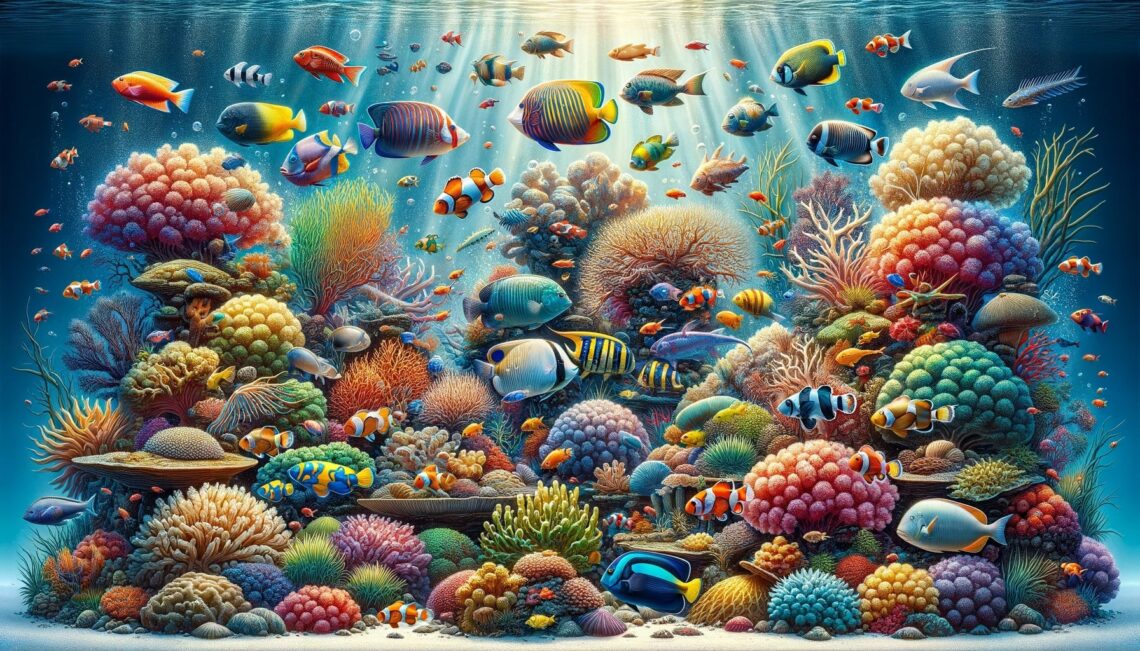Welcome fellow ocean enthusiasts! In this blog, I’m excited to share with you the captivating world of saltwater fish. From their vivid colors to their unique behaviors, these marine wonders offer a glimpse into the diverse life beneath the waves. Whether you’re an experienced aquarist or just starting, this guide will take you on an underwater journey exploring various species, their natural habitats, and tips for creating a thriving saltwater aquarium.
Summary
Saltwater fishkeeping is a rewarding hobby that combines the beauty of marine life with the challenge of creating a living ecosystem. It requires understanding the specific needs of different species, regular maintenance, and a commitment to sustainable practices. The guide encourages both beginners and experienced hobbyists to embark on this journey, offering a way to appreciate and contribute to marine ecosystems.
Key Takeaways
- Diversity of Saltwater Fish: Saltwater fish are diverse, ranging from small neon tetras to large whale sharks. Popular species include Clownfish and Blue Tang, each with unique characteristics and roles in their ecosystems.
- Saltwater vs. Freshwater Fish: There are notable differences between these two fish types, particularly in osmoregulation. Saltwater fish have adaptations to handle high salt levels, while freshwater fish are adapted to environments with lower salt concentrations.
- Choosing the Right Fish for Your Aquarium: Considerations include the potential size of the fish, their compatibility with other species, and the specific needs of each fish. For beginners, hardy and low-maintenance species like Clownfish and Damselfish are recommended, while experienced hobbyists might prefer exotic species like Lionfish and Mandarinfish.
- Aquarium Setup and Maintenance: Essential equipment includes filters, lighting, heaters, and aquascaping elements. Regular maintenance routines are crucial for maintaining water quality and the health of the fish. Weekly water testing and changes, filter maintenance, and equipment checks are vital.
- Coral Reefs in Aquariums: Corals add beauty and ecological value to aquariums. Different types of corals have varying care requirements, with some suitable for beginners and others for experienced aquarists. Corals often have symbiotic relationships with certain fish species.
- Feeding Your Saltwater Fish: Understanding the dietary needs of different fish species is key. Options include live, frozen, and dry foods. Regular feeding schedules, appropriate quantities, and variety in diet help ensure fish health.
- Common Challenges: Issues like algae growth and pests require specific strategies for control, such as regular tank maintenance and biological controls. Preventing and treating diseases is also critical, with practices like quarantine for new fish and regular water quality checks.
- Sustainable and Responsible Fishkeeping: Ethical sourcing of fish and corals and awareness of the environmental impact is important for conservation.
What are Saltwater Fish?
Saltwater fish, as the name suggests, live in the ocean or sea environments where the water is saline. These species are remarkably diverse, ranging from the tiny neon tetra to the majestic whale shark. As someone deeply fascinated by marine life, I find saltwater fish to be incredibly intriguing creatures.
Some popular species of saltwater fish include the Clownfish, known for its bright orange color and unique symbiotic relationship with sea anemones, and the Blue Tang, famous for its vivid blue and yellow coloring.
Importance in Marine Ecosystems Saltwater fish play vital roles in marine ecosystems. They are often key in maintaining the balance of their habitats, serving as both predator and prey in the food web. For example, larger species like the Grouper help control the population of smaller fish, while smaller species like the Sardine are crucial for transferring energy up the food chain.
Differences Between Saltwater and Freshwater Fish Saltwater and freshwater fish differ in several ways due to their distinct environments. Saltwater fish often have more efficient osmoregulation systems, allowing them to maintain the balance of salt and water in their bodies. In contrast, freshwater fish are adapted to environments with a lower concentration of salt.
Comparison of Saltwater and Freshwater Fish
| Feature | Saltwater Fish | Freshwater Fish |
|---|---|---|
| Habitat | Oceans, seas | Lakes, rivers |
| Osmoregulation | Handle high salt levels | Handle low salt levels |
| Skin type | Often thicker scales | Usually thinner scales |
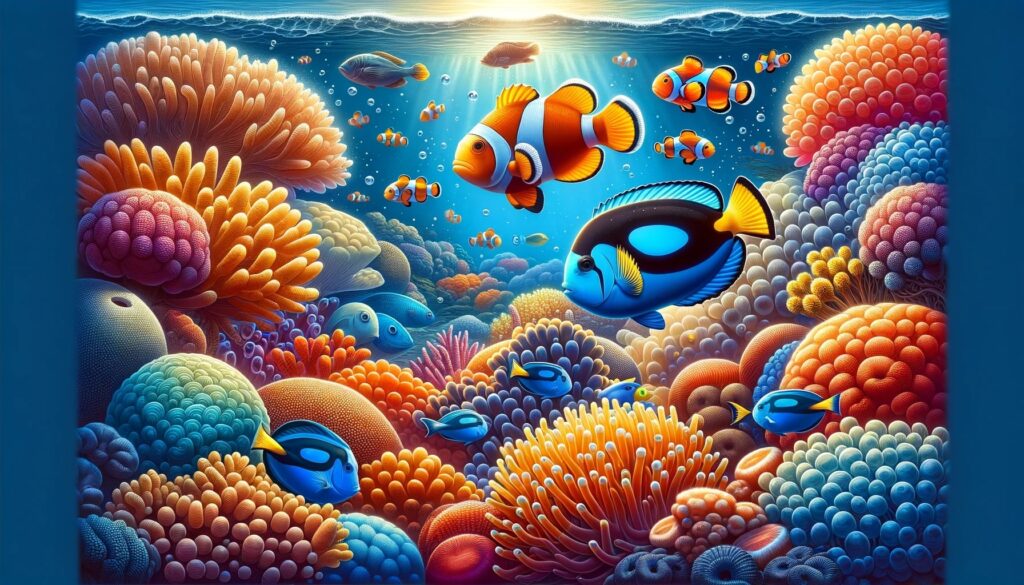
This insight into the world of saltwater fish highlights not just their beauty and diversity but also their critical role in our oceans. Understanding and appreciating these differences is key to conserving these marvelous species for future generations.
Choosing the Right Fish for Your Saltwater Aquarium
When setting up a saltwater aquarium, one of the most exciting yet challenging decisions is selecting the right fish. As an enthusiast myself, I believe it’s essential to consider several factors to ensure a harmonious and healthy aquarium.
Factors to Consider
- Size: It’s crucial to understand the potential size your chosen fish will reach as adults. This determines the minimum tank size required to accommodate them comfortably. For instance, while a Clownfish may thrive in a smaller tank, a larger species like the Angelfish demands more space.
- Compatibility: Fish compatibility is vital for a peaceful tank. Some species are more aggressive and may not coexist well with others. Researching the temperament and social behavior of each species is essential to prevent conflicts.
Popular Beginner-Friendly Species
Beginners should look for hardy, low-maintenance species that can tolerate fluctuations in water conditions. Some recommended options include:
- Clownfish: Famous for their vibrant colors and resilience.
- Damsel Fish: Known for their hardiness, though some can be territorial.
- Goby Fish: Small and generally peaceful, ideal for smaller tanks.
Unique and Exotic Options for Experienced Hobbyists
For those with more experience and a well-established tank, exploring unique and exotic species can be thrilling. These include:
- Lionfish: Known for their striking appearance, but require careful handling due to their venomous spines.
- Mandarinfish: With their vibrant colors and patterns, they are a visual delight, but demand a well-maintained environment.
- Butterflyfish: These are beautiful and come in various colors, but they have specific dietary needs that can be challenging to meet.
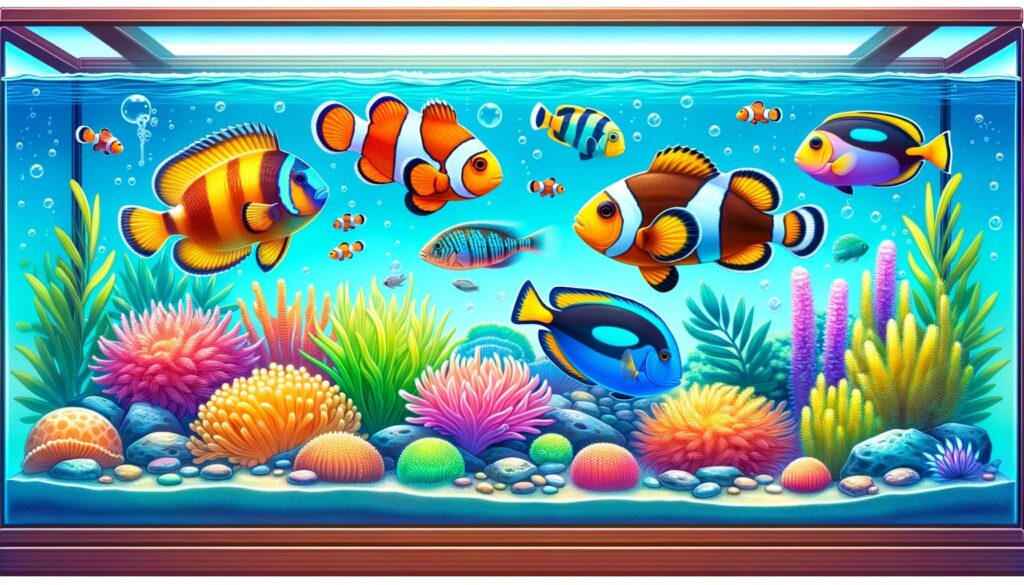
When planning your saltwater aquarium, remember that research and preparation are key. Each species has unique needs, and understanding them is crucial for a successful aquarium. For more detailed information on saltwater aquarium fish and how to care for them, you can explore the resources available at Oscar Fish Lover’s Fish Profiles Section.
Creating a thriving saltwater aquarium is a rewarding journey, blending the beauty of marine life with the satisfaction of cultivating a miniature ocean ecosystem right in your home.
Creating a Healthy Habitat: Aquarium Setup and Maintenance
Embarking on the journey of setting up a saltwater aquarium is both exciting and intricate. I’ve always been fascinated by the process of creating a mini-ocean ecosystem at home. To ensure the health and well-being of the marine inhabitants, it’s essential to understand and provide the right setup and engage in regular maintenance.
Essential Equipment for a Saltwater Aquarium
- Filters: A high-quality filter is crucial for maintaining clean water and removing toxins. Canister filters or sump systems are popular choices.
- Lighting: Proper lighting is essential, especially if you plan to keep corals. LED lights are energy-efficient and offer a spectrum suitable for coral growth.
- Heaters: Consistent water temperature is vital. Heaters help maintain the temperature, which is typically between 75-80°F for most saltwater species.
- Aquascaping Elements: Aquascaping elements like Rocks, driftwood, and substrate not only enhance the aesthetic of the tank but also provide hiding places for fish and surfaces for beneficial bacteria.
The Importance of Water Quality and Parameters
Maintaining optimal water quality is paramount in a saltwater aquarium. Regular water quality testing is needed to monitor parameters like pH, salinity, ammonia, nitrite, and nitrate levels. Saltwater fish are sensitive to changes in their environment, so keeping these parameters stable is key to their health.
Regular Maintenance Routines
- Weekly Water Testing: Check for ammonia, nitrite, nitrate, pH, and salinity levels.
- Regular Water Changes: Replace 10-15% of the tank water weekly to remove pollutants and replenish minerals.
- Filter Maintenance: Clean and check filters regularly to ensure they are functioning properly.
- Monitoring Equipment: Regularly check heaters, lights, and other equipment to ensure they are working correctly.
- Tank Cleaning: Regularly remove algae and clean the tank glass, substrates, and decorations.
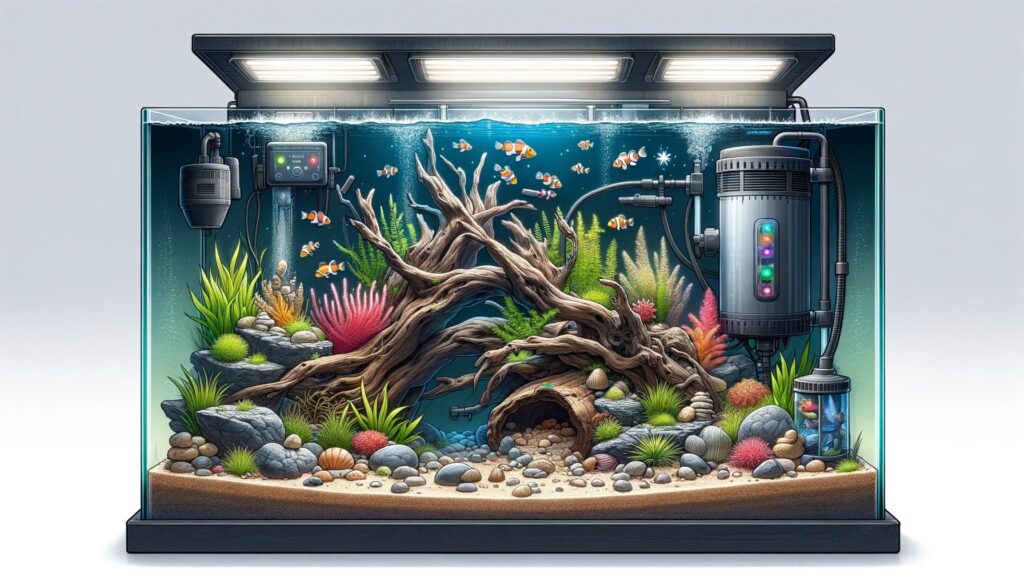
Setting up and maintaining a saltwater aquarium is a delightful challenge that requires dedication and attention to detail. For more insights on aquarium setup and maintenance, you can delve into the informative guides at Oscar Fish Lover’s Aquarium Setup.
Creating a thriving marine habitat is not just about aesthetics; it’s about replicating a natural, healthy environment for your aquatic pets. With the right equipment and maintenance practices, your saltwater aquarium can become a vibrant, dynamic underwater world.
The Spectacular World of Coral Reefs
Exploring the vibrant and intricate world of coral reefs is one of my most treasured aspects of marine aquarium keeping. Coral reefs, with their diverse array of colors and forms, not only add immense beauty to an aquarium but also play crucial ecological roles.
Types of Corals Suitable for Home Aquariums
- Soft Corals: Easy to care for and ideal for beginners. Examples include Zoanthids and Leather Corals.
- LPS (Large Polyp Stony) Corals: These are hardy and add a dramatic appearance to the tank. Examples are Brain Corals and Hammer Corals.
- SPS (Small Polyp Stony) Corals: More challenging to maintain, suitable for experienced aquarists. Acropora and Montipora are popular choices.
Symbiotic Relationships with Fish
Corals and certain fish species share beneficial relationships. Clownfish, for instance, find shelter among the stinging tentacles of anemones, a type of soft coral, gaining protection from predators. In return, they provide the anemone with nutrients through their waste.
Coral Care and Maintenance
- Lighting: Corals need specific light spectrums to thrive, often provided by LED lighting systems.
- Water Flow: Adequate water movement is essential for nutrient transport and waste removal for the coral polyps.
- Water Quality: Regular testing and maintenance of water parameters are vital. Stable salinity, calcium, alkalinity, and pH levels are crucial.
- Feeding: Some corals require supplemental feeding with planktonic solutions or specialized coral foods.

Maintaining a reef aquarium is both a responsibility and a privilege, offering a glimpse into the complex and beautiful world beneath the ocean. For enthusiasts looking to delve deeper into the fascinating realm of reef aquariums and coral care, comprehensive guides and tips can be found at Reef Aquariums on Oscar Fish Lover.
The spectacular world of coral reefs in a home aquarium not only provides an aesthetic pleasure but also an opportunity to learn and participate in the conservation of these delicate marine ecosystems. With careful selection, proper care, and an understanding of their unique needs, corals can thrive and add an extraordinary dimension to your saltwater aquarium.
Feeding Your Saltwater Fish: A Guide to Nutrition
Proper nutrition is paramount in maintaining the health and vitality of saltwater fish in an aquarium. Each species has its unique dietary needs, which must be met to ensure their well-being and longevity. As an avid aquarist, I’ve learned the importance of understanding these needs and tailoring feeding practices accordingly.
Understanding the Dietary Needs of Different Species
Saltwater fish vary widely in their nutritional requirements:
- Herbivores: Such as Tangs, need a diet rich in algae and plant material.
- Carnivores: Like Lionfish, require a protein-rich diet, often consisting of meaty foods.
- Omnivores: Species like Clownfish thrive on a mixed diet of plant and animal matter.
Understanding the natural diet of your fish is key to replicating it in the aquarium.
Types of Food: Live, Frozen, and Dry
- Live Food: Includes brine shrimp and microworms, providing natural hunting behavior stimulation. Best for finicky eaters or breeding fish.
- Frozen Food: A convenient option that can include a variety of meats and vegetables. It’s nutritious and can be stored for a long time.
- Dry Food: Comes in flakes or pellets and is suitable for most fish. Ensure it’s high quality to provide a balanced diet.
Feeding Schedules and Practices
- Regular Feeding: Most fish thrive on being fed 1-2 times per day.
- Quantity: Be cautious not to overfeed. A good rule is to offer only as much food as the fish can consume in a few minutes.
- Variety: To ensure a balanced diet, alternate between different types of food.
- Observation: Watch fish during feeding to ensure they are eating properly and to detect any health issues early.
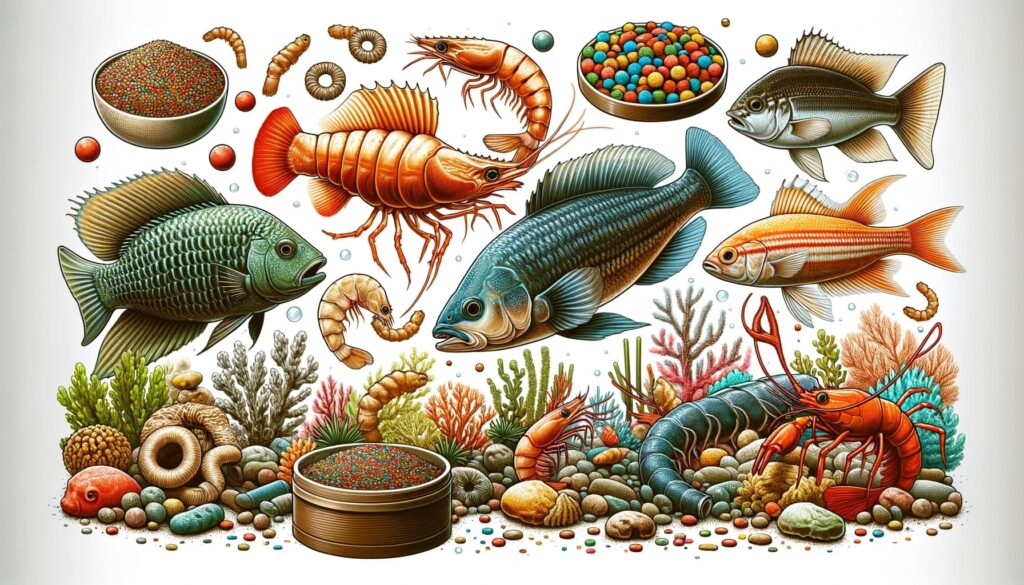
Proper feeding is not just about satisfying hunger; it’s about enriching the lives of these fascinating creatures and ensuring their health and vibrancy. For more detailed information on fish nutrition and feeding practices, you might find the resources at Oscar Fish Lover’s Nutrition Section highly beneficial.
In summary, a well-planned diet, tailored to the specific needs of your saltwater fish, is crucial for a thriving aquarium. By understanding and implementing appropriate feeding schedules and practices, you can enjoy the beauty and activity of healthy, vibrant fish in your saltwater aquarium.
Common Challenges and Solutions in Saltwater Aquaria
Maintaining a saltwater aquarium is a rewarding yet complex endeavor, often accompanied by challenges that require careful attention and effective solutions. As someone who has navigated these waters, I’ve learned that being proactive and informed is key to a healthy aquarium.
Dealing with Algae and Pests
- Algae Control: Algae growth is a common issue. Regular tank maintenance, controlling light exposure, and ensuring proper nutrient balance can help mitigate this. Additionally, introducing algae-eating fish or snails can be beneficial.
- Pest Management: Unwanted pests like aiptasia or bristle worms can be controlled through manual removal, biological controls (like certain fish or invertebrates), or, in some cases, chemical treatments.
Preventing and Treating Common Diseases
- Quarantine New Arrivals: Always quarantine new fish to prevent the introduction of diseases to your established tank.
- Water Quality: Maintaining optimal water parameters reduces stress on fish, lowering their susceptibility to diseases.
- Regular Observation: Early detection of symptoms like unusual swimming patterns or discolorations is crucial for timely treatment.
- Appropriate Treatment: Use the correct medications for specific diseases, ensuring they are safe for all tank inhabitants, including invertebrates.
Balancing the Ecosystem Within Your Tank
- Regular Water Testing: Consistently test water parameters to ensure they are within suitable ranges for your tank’s inhabitants.
- Stable Environment: Avoid sudden changes in temperature, lighting, or water chemistry, as these can disrupt the tank’s balance.
- Equipment Maintenance: Regularly check and clean filters, heaters, and other equipment to ensure they are functioning properly.
- Diverse Ecosystem: A well-planned tank with a mix of fish, corals, and invertebrates can help create a balanced ecosystem where different species support each other.
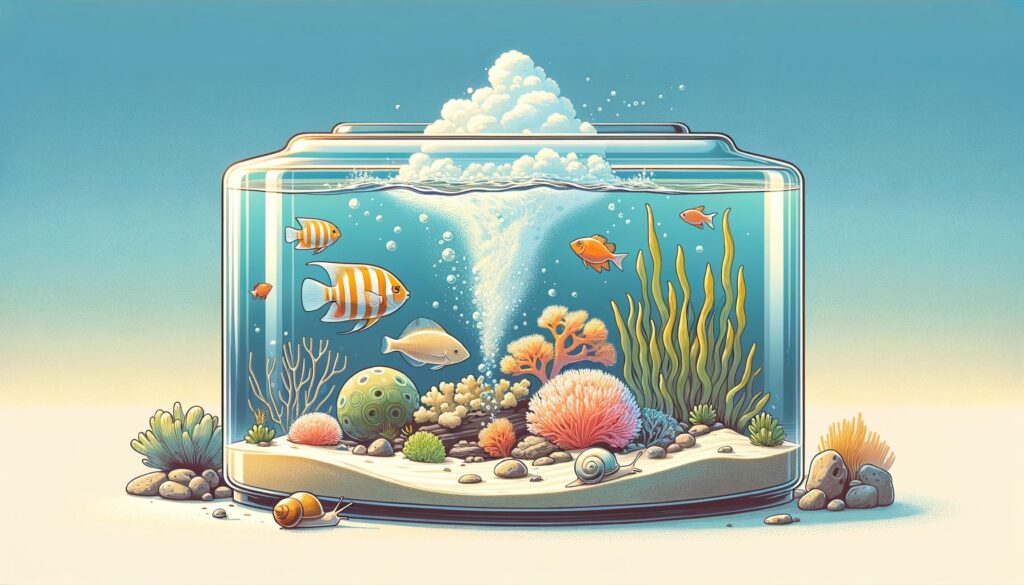
Dealing with the challenges in a saltwater aquarium requires a blend of vigilance, knowledge, and patience. For more in-depth guidance on addressing these issues, you can explore the resources available at Oscar Fish Lover’s Algae Control and Common Fish Diseases sections.
A thriving saltwater aquarium is a testament to the dedication and care put into it. By tackling common challenges with informed solutions, you can maintain a vibrant and healthy marine habitat in your home.
Final Thoughts and Inspiration
Saltwater aquariums offer a window into the fascinating world beneath the oceans, providing endless hours of tranquility and wonder. The journey involves continuous learning, patience, and care, but the rewards are immeasurable. As you delve into this hobby, remember that your efforts contribute not only to the well-being of your aquatic pets but also to a greater understanding and appreciation of marine ecosystems.
Whether you are a beginner or an experienced hobbyist, the world of saltwater aquariums offers endless possibilities for discovery and enjoyment. May your aquarium not only beautify your space but also serve as a testament to the beauty and diversity of life beneath the waves. Let your aquatic journey be guided by respect for nature and a commitment to the well-being of your marine inhabitants.
Relevant Links
- To learn about starting your aquarium, check out Starting Your Aquarium.
- For detailed aquarium setup guides, explore Aquarium Setup at Oscar Fish Lover.

